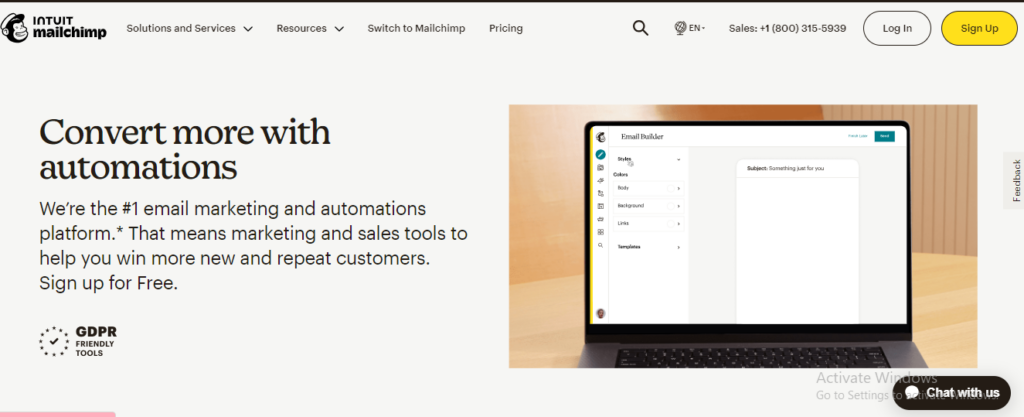Email marketing is a cornerstone of digital communication strategies, and two prominent platforms, Mailchimp vs SendGrid, vie for the top spot in the market. In this detailed comparison, we’ll delve into the intricacies of these platforms, dissecting their functionalities, strengths, and weaknesses. But before we dive into the comparison, let’s define each term for clarity.
Definitions of Mailchimp vs SendGrid

Mailchimp: Mailchimp is an all-in-one marketing platform that empowers businesses of all sizes to connect with their audience and drive growth through effective email marketing campaigns. With its intuitive interface and comprehensive suite of tools, Mailchimp simplifies the process of creating, sending, and analyzing email campaigns.
In addition to email marketing, Mailchimp offers robust audience segmentation capabilities, allowing businesses to target their messaging based on demographics, interests, and behavior. This enables personalized communication that resonates with recipients and increases engagement.
Automation is another key feature of Mailchimp, enabling businesses to streamline their marketing workflows and deliver relevant content to their audience at the right time. From welcome emails to abandoned cart reminders, Mailchimp’s automation tools help businesses nurture leads and drive conversions.
Furthermore, Mailchimp provides detailed analytics and reporting tools to track the performance of email campaigns. From open rates and click-through rates to conversion metrics, businesses can gain valuable insights into their audience’s behavior and optimize their marketing strategies accordingly.

SendGrid: SendGrid is a leading cloud-based email delivery service trusted by businesses worldwide for reliable email delivery and actionable insights. Designed for developers and marketers alike, SendGrid offers a range of tools and features to optimize email delivery and maximize engagement.
At the core of SendGrid is its powerful email API integration, which allows businesses to seamlessly integrate email functionality into their web applications and platforms. Whether sending transactional emails, notifications, or marketing campaigns, SendGrid’s API ensures timely and reliable delivery.
SendGrid also offers SMTP relay services, providing businesses with a scalable and secure way to send email through their existing infrastructure. With features such as IP warming and reputation monitoring, SendGrid helps businesses maintain high deliverability rates and avoid spam filters.
In addition to email delivery, SendGrid provides marketing campaign management tools to help businesses create, send, and track the performance of their email campaigns. From template design to A/B testing and analytics, SendGrid equips businesses with the tools they need to drive engagement and achieve their marketing goals.
Furthermore, SendGrid offers actionable analytics insights, allowing businesses to monitor email performance in real-time and make data-driven decisions to optimize their campaigns. With detailed reporting on delivery rates, engagement metrics, and spam complaints, SendGrid empowers businesses to continuously improve their email marketing strategies.
Both Mailchimp and SendGrid have established themselves as leading players in the email marketing industry. Mailchimp, founded in 2001, initially gained popularity as an easy-to-use platform for small businesses. Over the years, it has evolved into a comprehensive marketing platform offering email marketing, automation, and more. SendGrid, founded in 2009, specializes in email delivery and transactional email services, catering to developers and businesses of all sizes.
Also Read: The Ultimate Guide to Instagram Video Length: Posts, Stories, and Reels in 2024
Detailed Comparison
Now, let’s break down the comparison between Mailchimp vs SendGrid
| Feature | Mailchimp | SendGrid |
|---|---|---|
| Email Marketing | ✔️ Offers robust email marketing features with customizable templates, A/B testing, and segmentation options. | ❌ Limited email marketing capabilities focused primarily on transactional emails. |
| Automation | ✔️ Provides advanced automation features for creating automated email workflows based on subscriber actions and triggers. | ✔️ Offers automation capabilities for transactional emails and event-driven marketing campaigns. |
| Delivery Rates | ❌ Delivery rates may vary depending on factors such as sender reputation and email content. | ✔️ Ensures high deliverability rates through optimization techniques and reputation monitoring. |
| API Integration | ✔️ Offers API integration for seamless connectivity with other platforms and systems. | ✔️ Provides robust API integration options for custom email solutions and third-party application connectivity. |
| Scalability | ✔️ Suitable for businesses of all sizes, from small startups to large enterprises. | ✔️ Scalable solution capable of handling high email volumes and growing with business needs. |
| Analytics | ✔️ Provides detailed analytics on email performance, including open rates, click-through rates, and subscriber engagement metrics. | ✔️ Offers comprehensive analytics insights into email delivery, engagement, and conversion metrics. |
| Pricing | ✔️ Offers tiered pricing plans based on subscriber count and features, with a free plan available for small businesses. | ✔️ Pricing is based on email volume, with flexible pricing options suitable for businesses of all sizes. |
| Support | ✔️ Provides customer support via email, chat, and knowledge base resources. | ✔️ Offers 24/7 customer support through email, phone, and dedicated customer success managers. |
| Integrations | ✔️ Integrates with various third-party platforms and applications, including CRMs, ecommerce platforms, and social media channels. | ✔️ Offers extensive integrations with popular platforms, such as CRMs, ecommerce platforms, and marketing automation tools. |
Also Read: WP Event Manager Review: An All-in-one WordPress Event Management Plugin
Conclusion
In conclusion, both Mailchimp and SendGrid serve as powerful tools for email marketing and communication, each with its own strengths and capabilities. Mailchimp excels in providing a comprehensive marketing platform with advanced automation and segmentation features, making it ideal for businesses looking to engage with their audience through targeted email campaigns. On the other hand, SendGrid specializes in transactional email delivery and scalability, offering high deliverability rates and robust API integration options for businesses of all sizes.
Ultimately, the choice between Mailchimp and SendGrid depends on your specific business needs, budget, and marketing objectives. Whether you prioritize advanced automation, customizable templates, or high deliverability rates, both platforms offer solutions to help you succeed in your email marketing efforts.
Interesting Reads:
5 Best WooCommerce Wishlist Plugins in 2024








